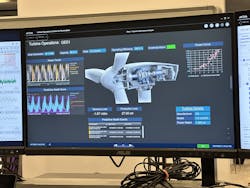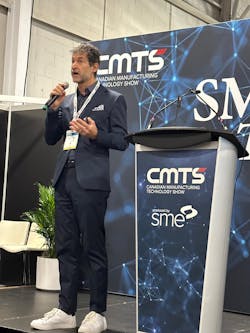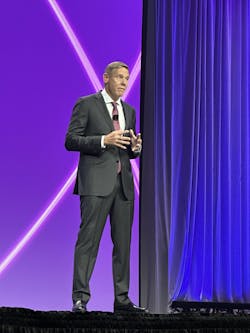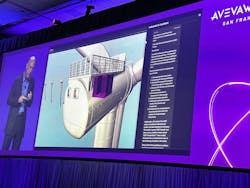Big Tech & Big Ideas Permeate Industrial Thinking in 2023
Throughout the year, Machine Design invites subject matter experts to share insights about up-an-coming technologies and market trends. Headline topics this year included sustainable practices, energy efficiency, advances in industrial automation technology and design for high-tech manufacturing.
A philosophical thread tying these topics together has been the need to “optimize for change” through the introduction of technologies. This theme was specifically laid out by Barbara Humpton, president and CEO of Siemens Corporation.
“If you listen closely, what we’re really talking about is who we are as people, and how we operate in this world of incredible opportunity,” Humpton said during her keynote at Automate 2023. “And the question I’ve been asking myself, and I hope you’ll join me in this quest, is to answer this question: Instead of trying to find an optimal state of being, what would it look like if we got our teams to focus on optimizing for being in a state of constant change?”
READ MORE: Making Conversation: Using AI to Extract Intel from Industrial Machinery and Equipment
In one fell swoop Humpton’s query would not only express a strategic purpose for her company, but also spotlight a trajectory overriding the industry.
It goes without saying that a range of global market forces underpin Siemens’ vision for the future, but “glocalization” rises as a key imperative. “Think about what we’ve experienced in just the last few years,” Humpton said during a press announcement on Nov. 3, 2023. “We’ve seen disruption and global supply chains reinforcing the need to not be overly reliant on one region for sourcing critical items. Supply chain challenges have been a major factor in evolving globalization into glocalization. It’s a world that’s bigger than ever. More global, evermore connected, but we’re capable of manufacturing things closer to the point of demand.”
Building Local Infrastructure
Supply chain vulnerabilities, as laid out in a White House report, can be traced to insufficient U.S. manufacturing capacity; misalignment in incentives that fail to reward firms for investing in long-term, sustainable productivity; and industrial policies and partnerships that lure away trade.
The report, Building Resilient Supply Chains, Revitalizing American Manufacturing, and Fostering Broad-Based Growth, is replete with examples highlighting fragility and disruption. Consider, for example, how the semiconductor shortage demonstrates the need to bring manufacturing back on course. A new car, stated the report, “may require more than 100 semiconductors for touch screens, engine controls, driver assistance cameras and other systems. The U.S. share of global semiconductor production has dropped from 37% in 1990 to 12% today, and is projected to decline further without a comprehensive U.S. strategy to support the industry.”
For Humpton, this historical dependence on globalization for finding the next incremental savings such as labor and materials on the supply side should be a thing of the past. Global supply chains must be supported by strong local manufacturing networks that will help the industry prosper, she argued.
To this end, Siemens announced in November that the company would be investing $150 million into a new high-tech manufacturing plant in Dallas-Fort Worth. Included in these plans will be the use of Siemens advanced manufacturing tools, including digital twin technology and the Siemens Xcelerator portfolio for capturing and analyzing data in real time from the shopfloor on production and product performance.
READ MORE: AVEVA Conference 2023: Sustainable Industrial Economies Will Depend on Digital Insights
“This is just the latest example of how Siemens is expanding our American manufacturing presence to meet demand,” Humpton said. “In the past year, you’ve heard that we’ve already seen Siemens invest $220 million into a new rail manufacturing facility in Lexington, N.C. And construction there is already underway. It’s in addition to some previously announced investments in two electrical products manufacturing plants, one in Grand Prairie and the other in Pomona, Calif.”
Among this year’s (October) rollouts, Microsoft and Siemens unveiled Siemens Industrial Copilot, an AI-powered jointly developed assistant aimed at improving human-machine collaboration in manufacturing. The tool allows users to rapidly generate, optimize and debug complex automation code, and shorten simulation times, noted a Siemens press release. The copilot extracts automation and process simulation information from Siemens’ open digital business platform, Siemens Xcelerator, and enhances it with Microsoft’s Azure OpenAI Service. Customers maintain full control over their data, and it is not used to train underlying AI models.
Generative AI is the Headline
No conversation this year has been complete without a reference to artificial intelligence tools such as OpenAI’s ChatGPT, Google’s Bard or Anthropic’s Claude.
Mainstream curiosity with artificial intelligence and generative AI have been unyielding since the launch of ChatGPT on Nov. 30, 2022. ChatGPT has reportedly garnered more than 100 million weekly active users. More than 92% of Fortune 500 companies are using ChatGPT and more than 2 million developers use it.
Simply defined, generative AI refers to a broad field of AI that has to do with developing techniques and models that are capable of generating new content. ChatGPT is a generative AI implementation trained on large language models and is designed for conversational purposes.
The capabilities of these technologies hold significant potential for transforming industries. The general use of AI-based solutions in the automotive industry, for instance, stretches across the lifecycle of a vehicle, from design and manufacturing to sales and aftermarket care. AI-powered chatbots, in particular, can deliver instant, personalized virtual driver assistance, are on call 27/7 and can evolve with the preferences of tech-savvy drivers.
READ MORE: Additive Manufacturing Innovations Drive Industry Forward
AI-driven intelligent assistant platforms are similarly working their way into the smart factory, said Ron Di Carlantonio, a Tokyo/Toronto-based computer scientist whose company, netpeople, developed a platform that allows companies to create intelligent, conversational assistants for their products.
Software-Defined Manufacturing Paradigm
The case for AI in industrial AI-based solutions was made clear at AVEVA’s flagship annual conference in San Francisco, where Caspar Herzberg, CEO of AVEVA, discussed how the company was building a new data infrastructure based on one industrial intelligence platform.
“This platform that we call Connect is designed to empower you at every step of the design, build, operate, optimize cycle, Herzberg said. “And what we are doing with our R&D is to bring disparate software together, so that users can easily exchange data, and so they operate seamlessly with each other.”
Whether data is accessed via the cloud, on premises or is hybrid, the goal is to enable the easy flow of “trusted data” between AVEVA’s solutions and its users, Herzberg said. “Trusted data in context is the foundation of the future; it is the foundation of industrial AI,” he said.
Building on a long-standing strategic partnership, AVEVA and Microsoft announced their relationship will be further cemented, as Connect and the Microsoft Fabric data analytics solution will now be interoperable to streamline the process of collecting, transforming and organizing data from various sources. Their combined offerings will leverage AI and machine learning (ML) and allow users to make better, faster data-driven decisions.
“Our view of the world over the next five to 10 to 15 years is as follows: We believe that industrial manufacturing and critical infrastructure is going to continue to grow through fairly dramatic transformation, ushered in by huge market forces and market dynamics, geopolitical uncertainties, supply chains, energy transition, sustainability, as well as the vortex of interesting new technologies such as cloud computing, edge, AI (generative AI for example),” said Rob McGreevy, chief product officer, AVEVA.
AI Makes Machines Talk
During the keynote McGreevy demonstrated how AVEVA has created industry specific use cases by tying predictive and prescriptive analytics capabilities together with large language models (LLMs).
A chat-based UI (user interface) was set up in McGreevy’s windfarm reference case. He prompted the program as follows: “The output we saw was lower than expected the last few hours. Are there any issues I should be aware of?”
Further interrogation allows the user to pinpoint all of the bearings and their temperature readings over the last 12 hours. The system lists all of the variables it is prompted for and infuses the response with real time min/max values.
“We’ve actually taken this and made it dynamic, whereas a lot of large language models are static,” McGreevy pointed out.
In the context of industrial manufacturing critical infrastructure, he said, generative AI is a toolset and a means by which companies like AVEVA can change the way users and community interact with the systems they design and build.
“Together, these things command a new way of doing things that demand a hyper, interconnected digital backbone upon which we can erect the building blocks for the next generation of our solutions,” said McGreevy.
About the Author
Rehana Begg
Editor-in-Chief, Machine Design
Rehana Begg is the head of content at Machine Design, where she translates complex engineering and manufacturing innovations into practical insights for design and multidisciplinary engineers. With more than 25 years of editorial experience and over a decade working across industrial manufacturing, Begg has covered automation, IIoT, robotics, mechanical design, additive manufacturing, plant operations, reliability and continuous improvement. Her reporting has taken her from corporate boardrooms to plant floors and underground mining stopes, giving her a frontline perspective on engineering challenges. She holds an MBA, a Master of Journalism, and a BA (Hons.) in Political Science. She is committed to lifelong learning and stays connected to the engineering community through ongoing technical engagement.
Email: [email protected]
LinkedIn: @rehanabegg and @MachineDesign
X: https://x.com/MachineDesign
Facebook: Machine Design
YouTube: @MachineDesign-EBM





